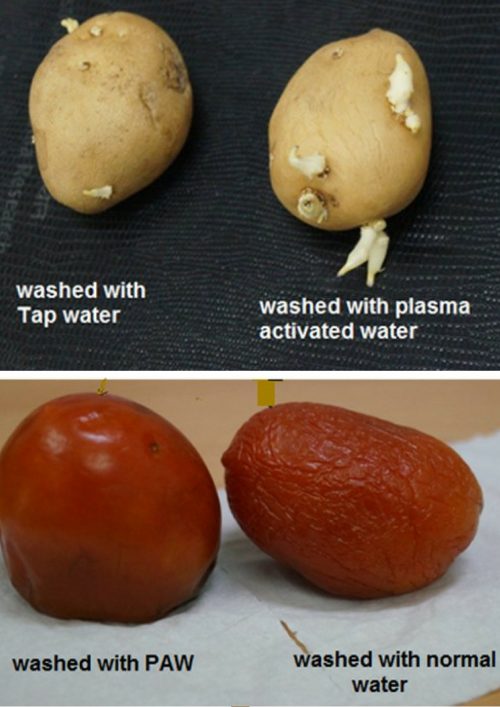Gujarat Scientists Create ‘Wonder Water’ That Can Keep Veggies Fresh For 40 Days!
Like a scene out of a comic book, scientists at the institution’s Facilitation Centre for Industrial Plasma Technologies (FCIPT) in Gandhinagar, treated normal water with non-thermal plasma.

Imagine a body of water that can kill of E.coli bacteria, fungal infection and even keep vegetables fresh throughout the summer?
That water would probably be wonder water. And like the name, it is an utter wonder discovery made by the scientists at the Institute of Plasma Research, Ahmedabad.
Like a scene out of a comic book, scientists at the institution’s Facilitation Centre for Industrial Plasma Technologies (FCIPT) in Gandhinagar, treated normal water with non-thermal plasma. The water turned into wonder water in due time.

Before delving into the superpowers of wonder water, we have to know what is “Non-Thermal Plasma”.
We all have been taught that there are only three states of matter: solid, liquid and gas. Well, it’s time to call out our science teachers as there are actually four states that matter exists in, and the fourth one is plasma.
In general terms, heating a gas dissociates its molecular bonds, rendering it into its constituent atoms. Further heating leads to ionisation (a loss of electrons), which turns it into plasma.
Non-thermal plasma is when heat inside the plasma is unevenly distributed. Most of the heat is stored in electrons rather than the ions and the neutrals here.
But how could over-heated gas cause water acquire superpowers?
When normal water is treated with non-thermal plasma shots, it becomes Plasma Activated Water (PAW). This water gets reactive nitrogen species, including nitrous oxide and nitric oxides as well as reactive oxygen species (ROS).
A senior IPR official told The Times of India, “When the water is treated with plasma charged air, it forms nitrates and nitrides in air which gets transferred to PAW and dissolves. It is these nitrogen species that prove beneficial for plants.”
The official describes the bacteria-killing property of wonder water in the following words, “Research have shown that PAW causes severe membrane damages in microbes like bacteria. Another aspect of PAW is that it is an acidic solution which also helps to broaden the antibacterial activity.”

The ToI article mentions an FCIPT journal, where Dr S K Nema, the head of the Atmospheric Plasma Division (APD), reported that tomatoes and potatoes once washed in PAW looked and remained fresh for nearly 40 days at room temperature.
Exploiting other antimicrobial property, Gujarat Environment Management Institute (GEMI) revealed that PAW eliminated all Escherichia coli (E. coli) bacteria in 30 minutes flat. Dr Natasha Khatri of GEMI said microbial tests on PAW were very encouraging.
A senior FCIPT-IPR scientist told TOI “We found that PAW becomes more potent to kill bacteria at higher oxidation-reduction potential (ORP). For instance, PAW induced with ORP of 200 millivolt kills E. coli in 15-20 minutes. The same PAW with an ORP of a high 800 millivolt can eliminate E. coli in a matter of seconds.”
Another area explored by FCIPT-IPR is the use of plasma to help in seed germination, plant growth and quality of the agricultural product. Chirayu Patil, claims in one of the FCIPT’s latest issues of Plasma Processing Update, “Plasma treatment has the potential of modifying surfaces of seeds to increase seed soaking. Atmospheric pressure plasma technology also offers great promise as a technique for food safety as well.”
If there is one promise of plasma for the future, it is plasma guns. But plasma water is a better replacement to achieve a better lifestyle. And if implemented, this could easily wipe out infections, keep people healthy, and most of all be easy to use.
(Edited by Shruti Singhal)
Hey, you may also like: This Simple Water-Saving Method Has Increased Rice Yield of TN Farmers 10-Fold!
Like this story? Or have something to share?
Write to us: [email protected]
Connect with us on Facebook and Twitter.
NEW: Click here to get positive news on WhatsApp!
If you found our stories insightful, informative, or even just enjoyable, we invite you to consider making a voluntary payment to support the work we do at The Better India. Your contribution helps us continue producing quality content that educates, inspires, and drives positive change.
Choose one of the payment options below for your contribution-
By paying for the stories you value, you directly contribute to sustaining our efforts focused on making a difference in the world. Together, let’s ensure that impactful stories continue to be told and shared, enriching lives and communities alike.
Thank you for your support. Here are some frequently asked questions you might find helpful to know why you are contributing?


This story made me
-
97
-
121
-
89
-
167













